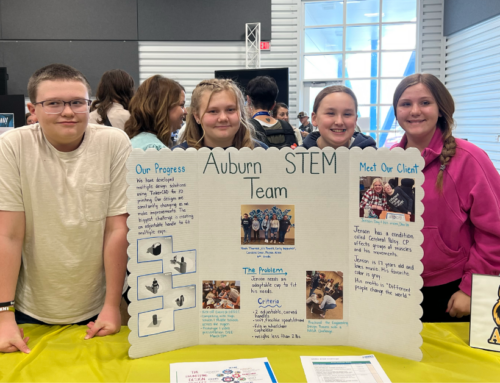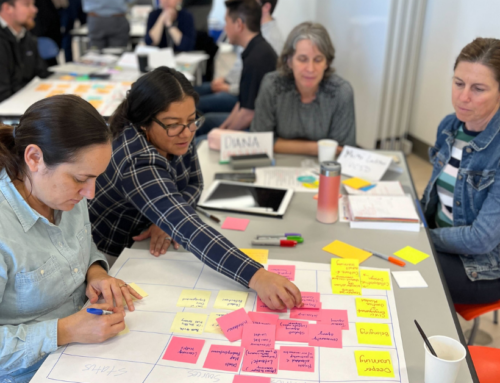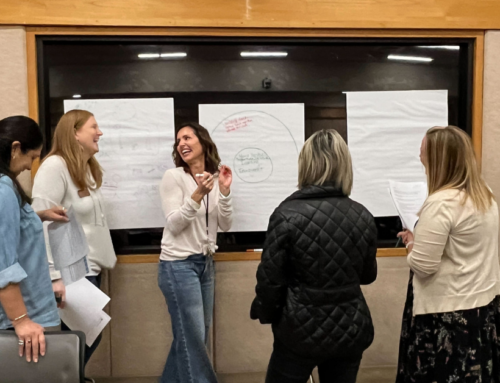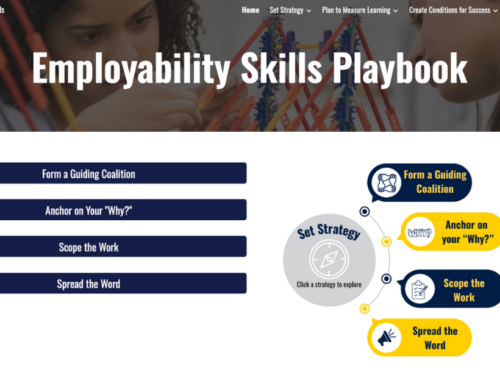
Traditional learning versus personalized learning is the difference between riding on trains and driving a car. In a train system, the path is pre-established by the tracks that guide and constrain the journey. The departure and arrival times, along with the pace of travel, are also predefined. While efficient for moving large groups of people, the experience of riding on the train is passive.
Driving a car, on the other hand, is an active experience. The driver is responsible for determining when to depart, which route to take, how fast to drive, how to adjust based on emergent conditions, and where to go. While less efficient in terms of mass transit than train travel, driving is the dominant mode of transportation due to the incredible flexibility and effectiveness that is enabled by empowering individuals to shape their own pathways.
Personalized learning has become a loaded buzzword, but this analogy begins to illustrate the complexities of shifting from a traditional, teacher-centered model to an innovative, student-driven approach to teaching, learning, and leading. What we need now, in the post-industrial era, is a model of learning that better represents the active engagement that occurs when students (pardon the pun) drive their learning.
Personalization Is Structured
Driving, while it is an individual activity, occurs in the context of a social system where drivers are interdependent on one another. There are rules of the road that are established to promote safe passage for all. In other words, while individuals have agency to determine their own path, there is a structure and a set of constraints that helps the system to function. In a personalized learning model the same concepts apply. Unbounded, unregulated driving would be hazardous and counterproductive. Unbounded personalized learning would also be unproductive and potentially harmful.
Paced Learning Is Important But Isn’t Enough
If driving is analogous to personalized learning, what are the new “rules of the road” that should be established to promote the type of stable dynamism that we want to see in this new model? The following is helpful in thinking about how to constrain and support personalized learning to maximize the positive impacts:
1. Some learning follows a relatively predictable and linear progression—I will refer to this as “ladder” learning, where a student proceeds from one rung on the ladder to the next.
2. Learning can also take the form of much more complex, open-ended challenges and projects that have patterns in their resolution but more than one right answer—I will refer to this as “knot” learning, which represents the entanglement and irregular shapes that emerge from series of knots.
Much of what is currently labeled as personalized learning has focused on ladder learning. This type of learning can be achieved through computer-based programs that help to resolve issues of pace but tend to offer very little flexibility in terms of pathways. Ladder learning systems usually have one right answer to a particular problem and generally are organized much like a series of progressively more difficult worksheets that are automatically scored by the digital technology which then generates the next worksheet for the learner. These ladder learning systems have been helpful in curricular areas that lend themselves to this approach, including concepts such as math facts and early literacy skills such as letter/sound recognition.
Knot learning is a much more challenging problem and more accurately reflects the thinking we do as adults. Effective educators have been masterfully organizing project-based learning experiences for many years, inspired to do so by the incredible impacts they see in both academic development and social-emotional learning. Tackling real-world challenges builds confidence and competence.
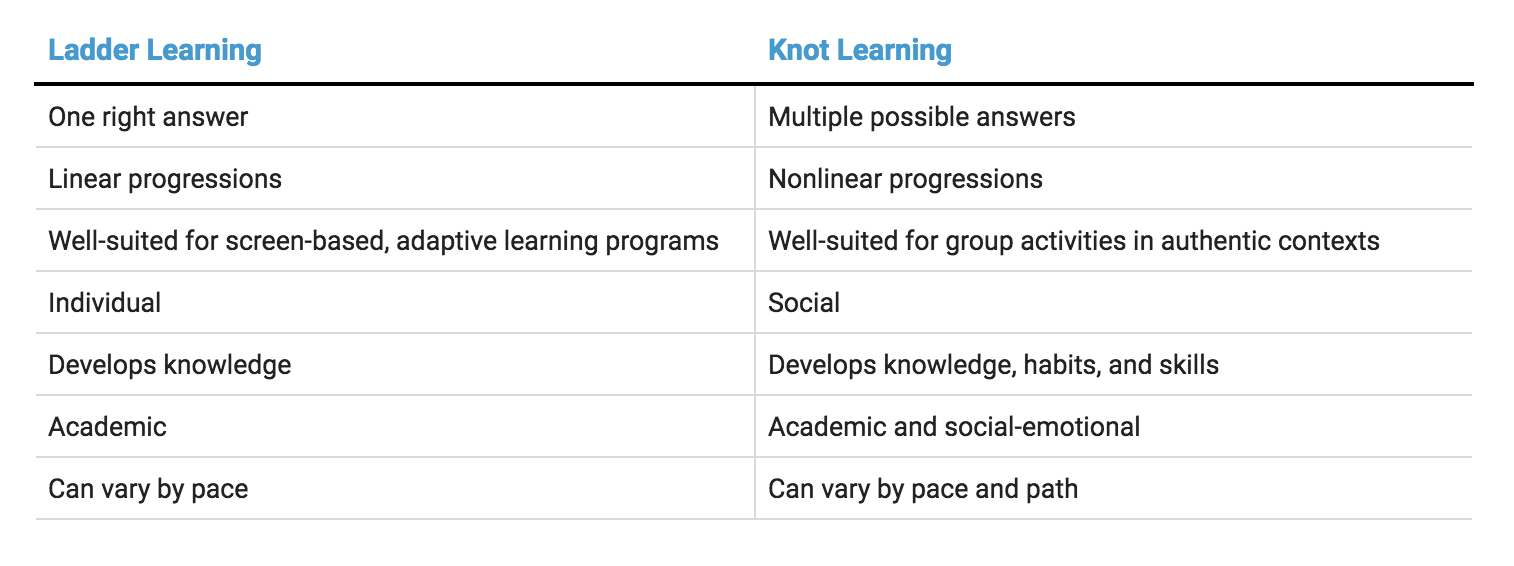
Empowering Students by Embracing Change
The ladder and knot models are analogues to the train tracks and the road systems. Just as our transportation system continues to evolve by building on the train system and by adding roads and highways, our educational system has an opportunity to take a massive evolutionary leap by transcending what we have done in the past. We need to continue to find ways to accelerate progress on ladder learning by using adaptive learning technology, and we need to embrace the complexities of knot learning by empowering students to drive their experiences.
There has been significant progress in the use of digital learning to catalyze progress with ladder learning, and we are now at the cusp of being able to also leverage technology as an accelerator for complex problem solving and project-based learning. But teaching a student to solve a math problem is a simpler task than asking a student to use math to resolve a complex social issue such as homelessness. Moreover, project-based learning can seem even more daunting when we consider how to use technology to better equip students to solve these complex problems.
The magnitude of the challenge is one of the reasons that it has never been done before.
Transformational Change Comes with Risks
The massive challenge of empowering learners to tackle real-world challenges is our focus at Learner-Centered Collaborative.
The risk of failure is real and the path to achieve this lofty ambition is uncertain. And yet we must weigh the risks of this uncertain journey against the risks of inaction. We know that the consequences of the status quo model are increasing disengagement of learners and graduation rates that have hovered around 80 percent for nearly five decades. I am not satisfied with those results and I fear for our collective future when we consider the individual, family, communal, and societal implications with the lack of education of so many who disengage from our current system.
Devin shares 3 Strategies to Transform Your School District Now
Improving the Pace and the Path of Learning
This may sound good in theory, but what does personalized learning look like in a classroom? When framed in the context of empowering students to drive their learning in the context of real-world challenges and accelerating the train-like ladder learning experiences, it is no surprise that one sees a mix of individual, self-paced learning in those areas that lend themselves to more linear progressions such as reading and math, with the remaining time focused on whole-class projects that emphasize collaboration, critical thinking, creativity, and communication. Reflection to promote metacognition and self-awareness is a common thread in both modes. While it is too early on the journey to know the exact right mix of these two main elements—which will likely vary based on context and the diverse needs of the learners—I see great potential by recognizing and amplifying the benefits of improvements in both the pace and path of learning.
For learners, this dual mode of personalization embraces individual progress and also promotes social development to build self-efficacy, collaboration, and problem-solving skills. A system designed for these two important elements of personalization ensures that learners are developing as individual contributors while also improving their learning communities.
The promise of personalized learning is that all learners can be the best version of themselves and improve communities and society. From my perspective, any learning model that falls short of those aspirations will fail our kids and place our society at risk. It is time we move beyond the simplistic notions of personalized learning and recognize that it is a “both/and” proposition that can better serve individual students and our collective society. It is time we lean into the complexities of the challenge. Our kids and our future depend on it.
To learn more about Devin’s views on personalized learning, see his TedX Talk “Embracing a Different Way.”
Access strategies and courses that support implementing personalized, learner-centered education in your context.

